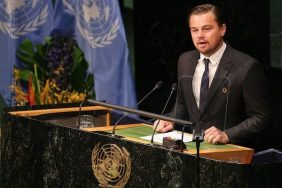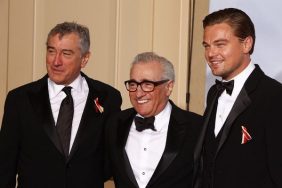Before the Flood, the new National Geographic documentary film by Academy Award-winning filmmaker Fisher Stevens and Academy Award-winning actor and United Nations Messenger of Peace Leonardo DiCaprio, opens with an image of The Garden of Earthly Delights, painted by Heironymous Bosch between 1480-1505. The triptych, on view at the Prado Museum, Madrid, one of the most famous paintings in Western art history, shows the Fall of mankind, as we travel from the pleasures of the Garden of Eden through the complex world of virtue and vice, to a dark and devastating Hell that offers no respite from it all.
Also: 5 Things You Need to Know About the Paris Agreement on Climate Change
DiCaprio muses on this painting, a poster of which hung over his crib, becoming his first visual memory; indeed it leaves an indelible impression upon all who encounter it. We recognize ourselves in the second and central panel, finding our way in the world, overcome by the complex mixture of beauty and perversion, virtue and vice. Eden, while idyllic, seems impossible, but it is Hell that strains our imagination so much that we hope to never know what might befall us in this realm.
But, as Before the Flood reveals, this dark world has already begun to manifest around the earth—at our own hand, no less. The magnificent growth made possible by the Industrial Revolution has come at a very real price. Our reliance on fossil fuels (oil, coal, and natural gas) to provide energy necessary to operate our modes of transportation and provide electricity to run our homes, offices, and factories has had a devastating impact on the planet over the past two centuries.
The use of fossil fuels releases carbon dioxide into the atmosphere, heating it up at a record pace that is melting the ice sheets, causing the oceans to rise. At the same time, the oceans begin to warm themselves, destroying the work it does to cool the planet. Add to this, the very act of obtaining these fossil fuels through mountaintop removal, fracking, offshore oil drilling, and tar sands makes the matter than much worse. But if this were not enough, forests are being razed to make way for palm oil plantations and grazing land for cattle, further adding to the carbon dioxide in the air while wiping out the very plant life cools the earth by consuming excess CO2.

Melting Glaciers, The Arctic Circle
It’s a vortex of devastation nearly impossible to imagine—unless you see it for yourself. In this way, Before the Flood does an incredible job in providing the visuals we need to begin to comprehend the scale of the problem worldwide. From a helicopter, DiCaprio takes us above the Suncor oil sands operations, where 350,000 barrels of synthetic crude oil are produced every day on the site of a former boreal forest. What was once a lush, verdant green oasis of flora and fauna has been laid to waste and in its place we see nothing the scar tissue of the earth. Putrid browns, grays, and blacks merge into a molten soup of toxic waste.
“Looks like Mordor!” DiCaprio exclaims to Mark Mageau, the Suncor SVP of Oil Sands Operations. “What?” Mageau asks, unable to hear him over the helicopter noise. DiCaprio repeats himself. Mageau hears him and falls silent.
It’s a horrific image, but only one of many throughout the film. From the Arctic to Argentina, Miami to Beijing, to New Delhi to Sumatra, the stakes are higher than they have ever been. Flooding. Air pollution. Ice sheets melting. The snow caps disappearing. Sea levels rising. The rainforests burned and razed. The coral reefs dead. Extinction spreading like a virus—begging the question, Who’s next?

Sunny Day Flooding, Miami Beach, Floria
Although it paints a grim picture, Before the Flood offers hope. We have the power within our hands if we are willing to protect the earth not just from our future generations but for us, in the here and now. Before the Flood offers a wide array of solutions, beginning right here at home. Forty-seven percent of United States land is used for agriculture, and of that figure, 70% is used to grow cattle feed. Imagine that: in this country cattle have more land dedicated to their diet than human beings. But the real problem is the methane gas cattle release while eating their feed; one molecule of methane is equivalent to 23 molecules of carbon dioxide. Imagine that: 10-12% of US greenhouse emissions can be traced to cattle farming. Eating less beef would clear the air that much more.
Then there’s electricity. Per capita, the United States is the highest consumer of electricity in the world. One American uses as much electricity as 10 Chinese, 34 Indians, and 64 Nigerians. Much of this can be accounted for by the massive growth of building larger homes and offices. The price of expansion is far greater than what is on the electricity bill.
Then there’s the unseen killer: palm oil, the cheap vegetable oil used in processed foods and cosmetics made by companies including Burger King, Tyson, Kraft Heinz, Smart Ones, Nissin, Pepsico, Sara Lee, Doritos, and Quaker, among others. In order to produce palm oil, the rain forests of Indonesia are being destroyed at a radical rate, destroying an ancient world filled with tigers, orangutans, rhinoceros, and elephants. It’s hard to conceive that the world is dying so that Americans can indulge their tastebuds, but there it is.

Rampant Deforestation, Sumatra, Indonesia
Before the Flood offers more solutions, ones that go further than our consumption habits. We can look to Sweden, which has become the first fossil fuel free nation on earth, and Denmark, which produces over 100% of its energy from wind. DiCaprio takes us inside a Tesla Gigafactory to meet with business magnate, engineer, and inventor Elon Musk. Musk has devised the Gigafactory, which could transition the entire world to natural energy—which is a free and renewable resource.
The possibilities for change, for a clean, safe earth really do exist—and they require far less from us than the dark, horrific alternative. Human nature, being pragmatic in the best of circumstances, lends itself to short-term thinking and immediate solutions. In that way, it cannot be stressed enough that the time is now. We will be far better off making these sacrifices than paying for denial and avoidance—a debt that is only going to escalate at an exponential rate and come due in the near future.
DiCaprio is to be commended for his determination to expand his role beyond the realm of entertainment, and give something back, something in which he admits his complicity and struggles with solutions, just like us. In addition to raising the issues, he meets with a wide array of experts, scientists, activists, and politicians including U.N. Secretary General Ban Ki-Moon, President Barack Obama, Secretary of State John Kerry, as well as Pope Francis. DiCaprio also includes the positions of climate change deniers like Ted Cruz, Marco Rubio, Florida governor Rick Scott, among others, allowing us a view of how the issue is being represented on the local, state, and federal levels.
Ultimately, Before the Flood is a must-see for anyone who cares about the fate of the Earth. We got ourselves into this mess, so it’s incumbent upon us ourselves so that we can do everything in our power to clean it up—before it’s too late.
All photos: Courtesy of National Geographic.
Miss Rosen is a New York-based writer, curator, and brand strategist. There is nothing she adores so much as photography and books. A small part of her wishes she had a proper library, like in the game of Clue. Then she could blaze and write soliloquies to her in and out of print loves.








